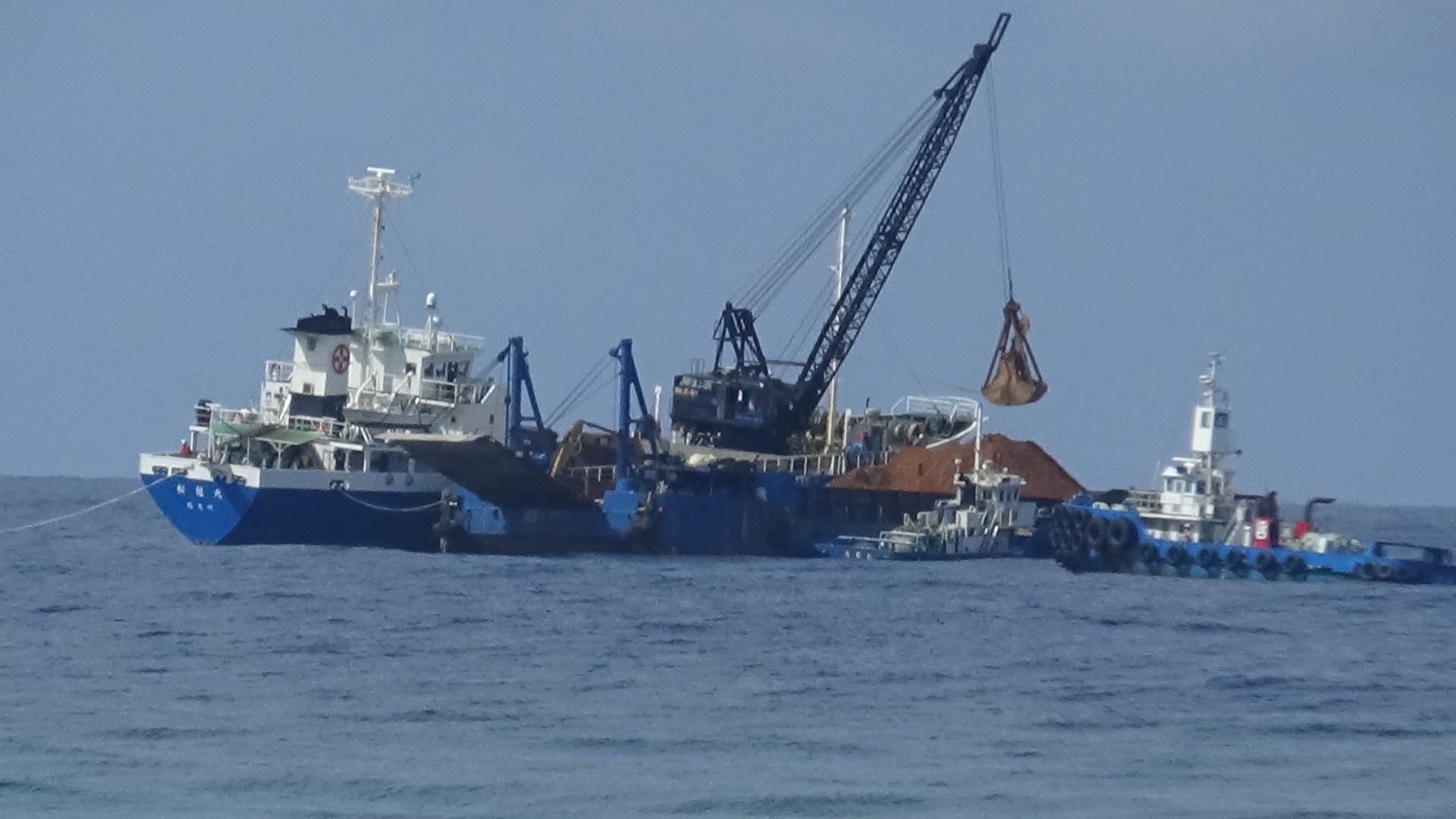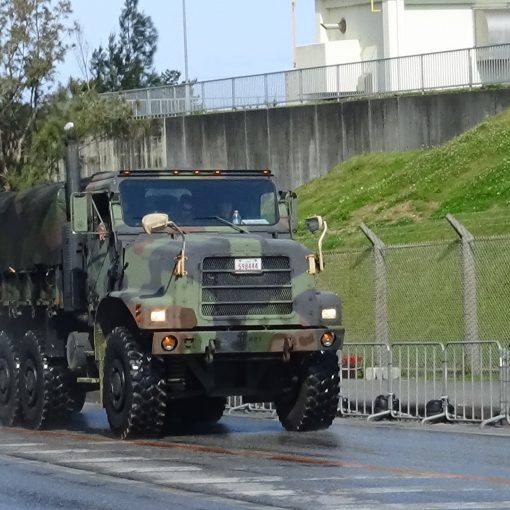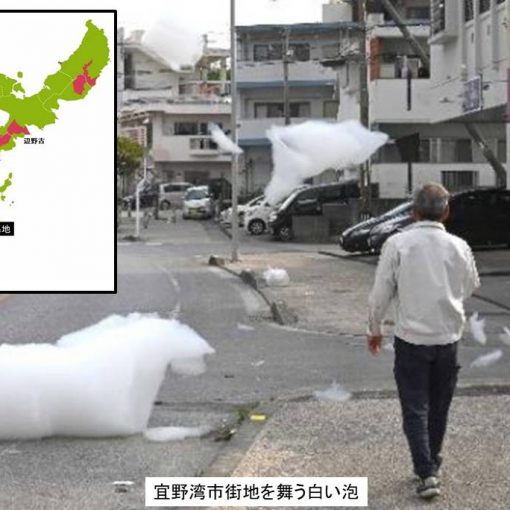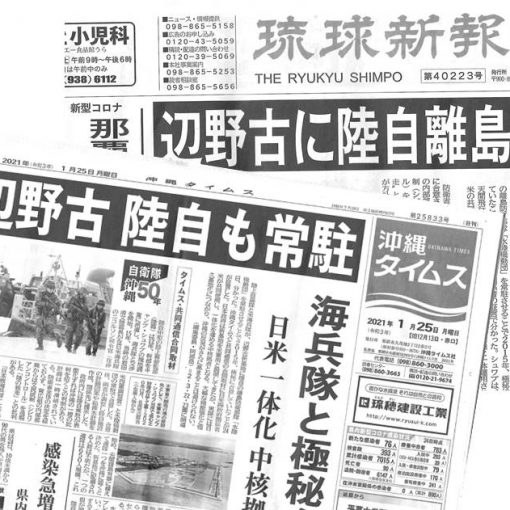It was from the articles in the Ryukyu Shimpo on Mar 27 in 2013, when Etsuko learned the shocking news that the central government decided to transport the earth and sand from the Seto Inland Sea to Henoko for the construction of the new base. Including Setouchi (Seto Inland Sea Area), listed were eight locations all in the Districts of Kyushu and Shikoku; Tokunoshima, Amami-Oshima, and others. She learned the first time that the government has a plan to collect and carry nearly 70% (16, 440,000m³) of the total sand needed for reclaiming the land for a new U.S. military base. She took immediate action to oppose this and appealed to the general assembly of Kan-Setonaikai-Kaigi (Pan Seto Inland Sea Conference), of which she is a member. After intense discussion, they confirmed the principle that they would not allow the Seto Inland Sea sand transported to Henoko.
In the Imabari City of Ehime Prefecture, she worked for about 30 years, protesting against landfills and harvesting sand from the Seto Inland Sea. Being a housewife but backed up by many people around her, she was elected to serve in the prefectural assembly.
Since then, she has been elected four times and served for 16 years. She visited the places on the government’s list and succeeded in starting up an opposition movement. Twenty organizations from nine prefectures joined.
One of the residents of Shodo-Jima impressed her, “The Osaka Castle used a large amount of stone collected here. If you take more, the island will get thinned. It is almost like selling a daughter.” At her lecture meeting in Amami-Oshima, she was also moved when she strongly felt the affection for Okinawa expressed by the islanders.
Her friends advised her not to go out at night since the gangsters might attack her. Gangs might target her. Sand and stone business involves the interest of various stakeholders.
The government changed its plan to collect the sand and stone from within Okinawa Prefecture rather than outside. “The locations left on the list for sand and gravel collection are those where no opposition movement is active.” She wonders if the government has virtually eliminated un-cooperative areas.
She has visited Okinawa frequently and interacted with many people in the Towns of Motobu and Nago. “The happiest thing for many years of involvement is having made good friends,” she emphasized. She intends to visit the places where opposition movements are not yet quite established, such as the Prefectures of Kagoshima and Kumamoto. She finalized the movement slogan through many years of work: “There is not a grain of sand in my or your homeland for war!”

(In front of Camp Shwab Gate)
It was the day the heavy rain came occasionally. About 40 protesters wrapped in rain-gear raised the voices of protest in front of the gate. The female members led the rally today, and they resisted more strongly than the male protesters usually do against the riot police officers who forcibly remove the protesters. The young policemen seemed confused, facing the familiar female protesters who talked incessantly about Okinawa’s history and damages caused by the U.S. military bases while resisting the forcible removal.
Daniel Iwama (35), a visiting researcher at the University of the Ryukyus, joined the protest. He is a second-generation Okinawan whose grandfather immigrated to Canada after the War. “I would like to learn about Okinawa before and during the War from the elderly in Okinawa. It will link me with Okinawa.” His contract with the University ends next March, but he wants to live permanently in Okinawa if he can find a job.



(Ryukyu Cement Awa Pier)
Thirty members, including the Okinawa Heiwa Shimin (Okinawa Peace Citizens’ Association), protested at the pier’s entrance and exit. The severe restrictions that the riot police commander exercises at the exit gate are the same today. He warns harshly using a hand microphone and blocks the sidewalk for over 10 minutes to let the dumps go. The protesters complained about the excessive and unjustified use of his power, “Pedestrians should have the priority access to the sidewalks!”
Three men who looked like the staff of the Defence Bureau came to the site. When we tried to take a photo, they turned their back to us. They might be discussing how they could catch up with the delayed work. Their visit to the site may be the indication that our protest is affecting the construction. No matter what they do to stop us, there will be no change in the protesters’ determination.
A total of 890 truckloads of sand and soil was loaded to four vessels.



(Motobu Shiokawa Pier)
About 15 protesters demonstrated by crossing the road slowly. Since the number of protesters is more than usual, the riot police appeared. Walking on the road is not against the law, and the only thing the police can do is ask us to walk faster. It caused the dump trucks crowding the port grounds and successfully delayed the operation. A total of 388 truckloads was loaded to four vessels.

Number of dump trucks to date and percentage against the total
The estimation calculated on the basis of the number of ruckloads serves only as a reference.
Number of dump trucks which made delivery from December 2018 to the end of December 2019 114,601(1.39%)
| 26(Sat) | 28(Mon) | 29(Tue) | 30(Wed) | Oct.1 (Thr) | 2(Fri) | |
| Awa | 967 | 554 | 282 | 890 | ||
| Shiokawa | 0 | 618 | 521 | 388 |
| Number of dump trucks ※ |
Weightt of earth/sand
※① |
Converted to volume
※② |
Volume per Total
※③ |
| 252,055 | 1,260,028t | 630,138㎥ | 3.119% |
※ Cumulative since Dec. 1, 2019
※① Calculated by assuming that the average truckload per dump truck would be 5 tons
※② Calculated by assuming that a specific weight of soil/sand set to be 2
※③ Percentage against 20.200.000m3, the total volume of earth and sand required for the landfill.





